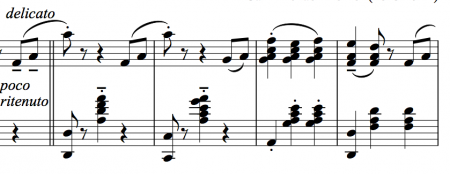
“Such serviceable flowers” The polka mazurka as the chrysanthemum of the ballet class
You’ll probably look at this and think it’s a bit dull. I can live with that, because I know you’re going to thank me one day when you get some really awkward exercise that needs to be like doing a hill-start at traffic lights every bar. As Miss Brodie says of chrysanthemums in The Prime of Miss Jean Brodie “Ah chrysanthemums. Such serviceable flowers.” A withering remark, but nonetheless, if serviceable is what you need, then a polka mazurka (or a bunch of chrysanthemums) is the thing.
Truly triple meter and the polka mazurka
I’m very glad that I made the distinction from the start in this series between 3s that were really more like 6/8s (hearts) and 3s that are really 3s, because this is a perfect example of truly triple meter, and why polka mazurkas, twee and 19th century as they are, are often much better for pirouette exercises than waltzes. See previous posts on triple metre, and waltzes and mazurkas.
I’m making up all the articulations in this transcription, because I have no score to refer to, so I’m just writing down what I can hear. Listen to the recording, because everything about this piece is about articulation and tempo, rather than notes (and that’s why it looks a bit dull on the page).
Wurf-bouquet means a “throwing bouquet” (presumably like the one you throw at weddings), and my guess is that there’s some musical gesturing going on in the melody, where the three-note motif (and the way the anacrusis is held back in performance) is meant to represent the preparation and throw of a bouquet. It’s the kind of thing we get used to doing in music all the time if you play for class. I haven’t transcribed the ending of the piece – it goes back to the beginning, and then spends about a minute winding down, which is not much use to anyone in class.
There are some interesting similarities between this and the opening of the Grand pas classique in Paquita, which will tell you pretty much for certain that what we have in the ballet is a polka mazurka. That being the case, as lovely as the production below is, I’m guessing it’s probably a bit racier tempo-wise than the original might have been. I could be wrong – one of the useful things Zorn told us was that Russians waltzed faster than most of the rest of Europe at the end of the 19th century, so maybe that applies to the polka mazurka too. The long-short-short-long pattern in some of the bars is identical, and is worth keeping in your tool-box as a means of slowing down waltzes for pirouette exercises.
I’m a week behind, as I was at the 2nd Music and Consciousness conference in Oxford last week. Given that other people manage to con prisons into releasing them by setting up email accounts using an illicit mobile phone, you’d think I ought to be able to blog my way through a conference, but I needed a midi keyboard and more time and brains than I had at the end of the day. I’ll catch up soon.

